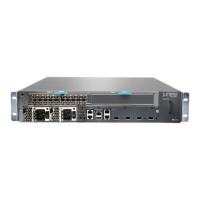CAUTION: Avoid bending fiber-optic cable beyond its minimum bend
radius.An arc smallerthan a few inches in diameter can damage the cable
and cause problems that are difficult to diagnose.
CAUTION: Do not let fiber-optic cable hang free from the connector. Do
not allow fastened loops of cable to dangle, which stresses the cable at
the fastening point.
5. Insert the other end of the cable into the destination port.
6. Repeat the previous steps for any additional cables.
7. If the MIC is offline (its failure indicator LED is lit), use one of the following methods
to bring it online:
•
Press the MIC offline/online button until the MIC LED lights green.
•
Issue the following CLI command:
user@host>request chassis mic fpc-slot slot-number mic-slot slot-number online
The normal functioning indicator LED confirms that the component is online. You can
also verify correct MIC functioning by issuing the show chassis fpc pic-status command.
Related
Documentation
MX5, MX10, MX40, and MX80 Modular Interface Card Description on page 23•
• Removing a Cable on an MX5, MX10, MX40, and MX80 MIC on page 126
• Replacing an MX5, MX10, MX40, and MX80 SFP or XFP Transceiver on page 130
• Preventing ElectrostaticDischarge Damage to an MX5, MX10, MX40, and MX80 Router
on page 194
• request chassis mic
• show chassis fpc
Installing an MX5, MX10, MX40, and MX80 Transceiver
To install an SFP or XFP:
1. Attach an ESD grounding strap to your bare wrist and connect the strap to one of the
ESD points on the chassis.
2. Take each transceiver to be installed out of its electrostatic bag, and identify the slot
on the component where it will be installed.
129Copyright © 2017, Juniper Networks, Inc.
Chapter 19: Replacing Line Card Components

